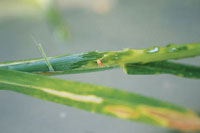Gall midge outbreak may force rethink on 2010 cropping plans

Growers with continous wheat crops affected by saddle gall midge infestations this season are being urged to consider growing a non-cereal next season.
Unprecidented numbers of saddle gall midge (Haplodiplosis marginata) have been decimating some continous wheat crops, including one Buckinghamshire farm where 100% of tillers had been affected.
NIAB TAG agronomist David Parish says that although controlling an outbreak of the larvae is not impossible – Dursban (chlorpyrifos) being most suitable – but timing has to be spot-on. Only a small window of opportunity exists, when the eggs are visible on the leaf surface, to achieve effective control. “After this the larvae move down the plant and are protected by the leaf sheath.
“The most reliable way to avoid it next year may well be to alter the rotation so that the particular field is not in cereal production,” he says.
Because the midge’s lifecycle contains an overwintering stage, the risk is greatest for continuous wheat. In affected crops, growers should first assess the damage and quantify the impact on yields. With this information a decision can be made on the risk of continuing with wheat or growing a break crop instead, with the other challanges that this can bring.
“Low to moderate damage and you may consider not taking action. The likelihood of having a repeat year of specific weather conditions favourable for the saddle gall midge is relatively small.
“If you choose to break the continuous cropping system, you’ll also need to take into account the potential for take-all two or three years after the break crop.”
This season’s sudden outbreak is thought to be down to the cold winter’s effect on the midge’s usual predators, combined with weather that’s encouraged localised population explosions.

